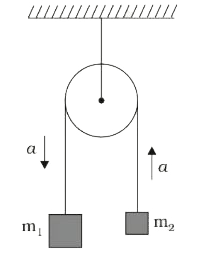A body A of mass M while falling wertically downwards under gravity brakes into two parts, a body B of mass 13 M and a body C of mass 23 M. The center of mass of bodies B and C taken together shifts compared to that of body A towards
body C.
body B.
depends on height of breaking.
does not shift.
The correct Answer is:D
Step by step video, text & image solution for A body A of mass M while falling wertically downwards under gravity brakes into two parts, a body B of mass (1)/(3) M and a body C of mass (2)/(3) M. The center of mass of bodies B and C taken together shifts compared to that of body A towards by Physics experts to help you in doubts & scoring excellent marks in Class 11 exams.
Updated on:21/07/2023Topper's Solved these Questions
- FORCE Book:TARGET PUBLICATIONChapter:FORCE Exercise:Competitive Theinking (4.10 Conditions of equilibrium of a rigid body)
Explore 1 Video
- FORCE Book:TARGET PUBLICATIONChapter:FORCE Exercise:Competitive Theinking (Miscellaneous)
Explore 26 Videos
- FORCE Book:TARGET PUBLICATIONChapter:FORCE Exercise:Competitive Theinking (4.7 Couple and properties of couple)
Explore 1 Video
- ELECTRONS AND PHOTONSBook:TARGET PUBLICATIONChapter:ELECTRONS AND PHOTONSExercise:Evaluation Test
Explore 19 Videos
- FRICTION IS SOLIDS AND LIQUIDS Book:TARGET PUBLICATIONChapter:FRICTION IS SOLIDS AND LIQUIDS Exercise:MCQ (EVALUATION TEST)
Explore 21 Videos
Similar Questions
Knowledge Check
On a straight line passing through the foot of a tower, two points C and D are at distances of 4 m and 16 m from the foot respectively. If the angles of elevation from C and D of the top of the tower are complementary, then find the height of the tower.
ABody CBBody BCDepends on height of breakingDDoes not shiftPosition of center of mass of a body
ALies always at the geometrical center.BLies always inside the body.CLies always outside the body.DMay lie within or outside the body.A body falling vertically downwards under gravity breaks in two parts of unequal masses. The centre of mass of the two parts taken together shifts horizontally towards
Aheavier pieceBlighter pieceCdoes not shift horizontallyDdepends on the verical velocity at the tiem of breaking
Two bodies of masses m1andm2(<m1) are connected to the ends of a massless cord and allowed to move as shown in figure. The pulley is both massless and frictionless. The acceleration of the centre of mass is (m1−m2)n(m1+m2)2g. Find the value of n.

View SolutionA body falling vertically downwards under gravity breaks in two parts of unequal masses. The centre of mass of the two parts taken together shifts horizontally towards
View SolutionA body A mass m1 exerts a force on another body B of mass m2 . If the acceleration of B be a2 , then the acceleration (in magnitude) of A is
View SolutionA body of mass M moves with velocity v and collides elasticity with another body of mass m(M>>m) at rest , then the velocity of the body of mass m is
View SolutionA body of mass m is taken to the bottom of a deep mine. Then
View Solution

